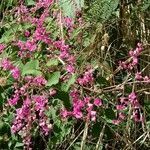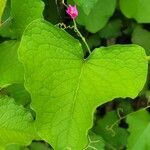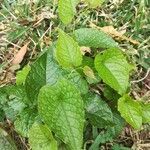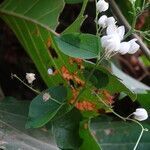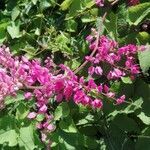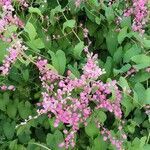A vine which loses its leaves during the year. It climbs to a height of 3-12 m. The twigs end in tendrils for climbing. These can be simple or branched. The vine has many branches. The stem is slender and wiry. The leaves are dark or bright green and heart shaped or almost triangular. The edges of the leaves have saw like teeth. The leaf is often wavy. The leaves are 5-14 cm long. The leaf stalk is 8-20 mm long and clasps the stem. The flowers are rose pink and bell shaped. Flowers can be of 2 sexes or of one sex. The flowers are 1.5-2 cm across. They occur in sprays of 6-15 flowers in sprays which can be 15-60 cm long. The seed or small nut is 3 sided with enlarged outer lobes. The tuberous roots are edible.
on the petioles forming flanges up to 5 mm. wide. Inflorescences of axillary and terminal capreolate racemes or panicles, the rhachises glabrate to densely pubescent. Flowers pedicellate, the glabrous to densely pubescent pedicels mostly articulated below the middle; tepals pink to purplish, cordate, in fruit 8-25 mm. long, 4-20 mm. broad, glabrous to closely pubescent without, rarely stipitate-glandular within; stamens 8, connate about half their length to form a filament tube, often with 1 tooth intercalated between the free portions of adjacent filaments; ovary tri-gonous; styles 3, arcuate; stigmata peltate. Achenes bluntly triquetrous, usually included, about 1 cm. long.
Glabrous to densely cinereous-or rufous-pubescent tuberous vines. Leaves broadly cordate to narrowly deltoid, acute to acuminate, often mucronate; blades mostly 3-14 cm. long, 2-12 cm. broad, glabrate to closely pubescent below; petioles mostly 1-2.5 cm. long, glabrous to pubescent, the leaf bases occasionally decurrent
Perianth red or white, 5(6)-merous; perianth segments petaloid, unequal, accrescent, the outer ones the largest, 4–8 × 2.5–5 mm increasing to c. 15 × 10 mm in fruit, broadly ovate, obtuse at the apex, cordate at the base, greenish, with reticulate veins; the inner ones smaller, oblong-elliptic.
A shrubby climber with tendrilous branches.. Cordate leaves with petioles basally ± amplexicaul but without ocreae.. Tepals 6 (3 + 3) pink or white, accrescent, papery, reticulately veined, up to about 2 cm. long.. Nuts 8–9 mm. long, very acute and sharply trigonous in the upper half.
Flowers pedicellate, solitary or in clusters subtended by bracts, arranged in axillary racemes, the uppermost racemes terminal, divaricate, becoming panicle; racemes usually ending in branched tendrils; pedicels up to 6 mm long, slender, ± puberulous.
Leaves petiolate; lamina 6–11 × 2.5–7.5 cm, triangular-ovate, acute at the apex, cordate or hastate at the base, entire or undulate on the margin, pubescent on the nerves, mainly beneath; petiole 1–3 cm long, puberulous.
Stamens 7–8; filaments unequal, the longer ones up to 1.5 mm long, alternating with smaller ones, united at the base to form a tube with teeth that alternate with the stamens; anthers 0.55 × 0.45 mm, broadly elliptic.
A climbing herbaceous perennial with tendrils present on the inflorescence, ± woody at the base; roots with ellipsoid tuberous swellings.
Nut brown and shiny, c. 1 cm long, ovoid, somewhat trigonous, included in the accrescent perianth and staminal tube.
Stems up to 5 m tall, puberulous, glabrescent, furrowed, slightly thickened at the nodes.
Ovary 0.7–0.8 mm long; styles 3, 0.3–0.4 mm long.
Ocrea reduced to an annular crest.
